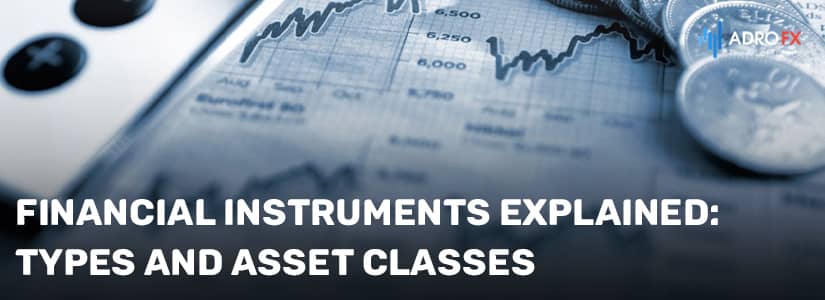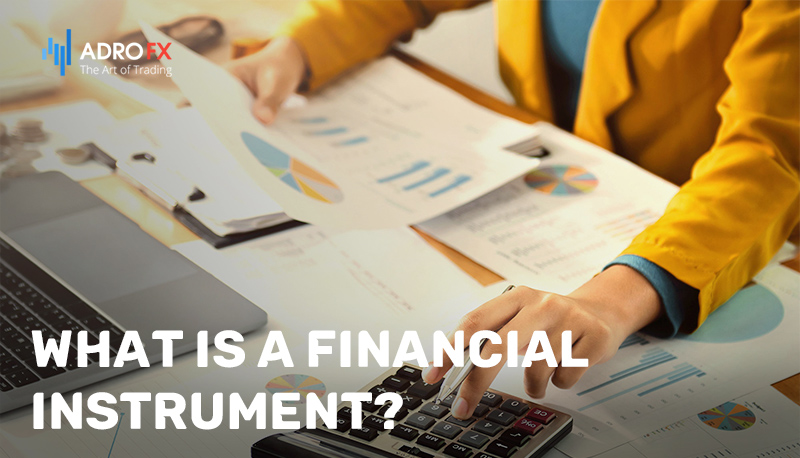Financial Instruments Explained: Types and Asset Classes

Every beginning investor, having defined his investment objectives and risk profile, thinks about how to structure his portfolio so that it meets his needs. There are a large number of financial instruments on the market and the question of proper portfolio structuring is more relevant than ever.
What Is a Financial Instrument?

A financial instrument is any contract by means of which there is a simultaneous increase in financial assets of one enterprise and financial liabilities (of debt or equity nature) of another. A distinction is made between primary financial instruments, represented by cash, types of securities, accounts payable and receivable on current transactions, and secondary, or derivative.
There are four types of markets: currency market, futures market, short-term market, and stock market. Each of them uses different financial instruments, i.e. documents that can be sold or transferred to get returns. Securities are traded on the stock market, and they are its main instrument. In essence, they are certain types of liabilities, with the help of which one invests funds - investing.
The Different Types of Financial Instruments
Let's start at the beginning. All securities are traded on the stock exchange, where all assets represented on it are traded in an organized manner. The instruments themselves are divided into two types: basic (cash) and derivatives. The first refers to usual securities and goods: shares, bonds, stock indices, interest rates, currencies, raw materials, energy, and others.
A derivative financial instrument is an agreement (contract) between two parties for the execution of a predetermined transaction with an underlying asset. As a rule, this is the purchase, sale, delivery, or transfer of securities and assets at a predetermined price at a specified time. Derivative financial instruments are also called secondary instruments.
Cash Financial Instruments
Cash instruments are defined as instruments that can be transferred and valued readily in the market. Some of the most common examples of cash instruments are deposits and loans which the lenders and borrowers are required to be agreed upon.
Stocks and Shares
The most popular type of financial instrument is a share - a security that secures the rights of its owner to receive part of the earnings of a joint stock company in the form of dividends, to participate in the management of the company, and the property that remains after its liquidation.
Shares can be ordinary and preferred. The rights of holders of ordinary and preferred shares differ: preferred shares do not give the right to vote, but, as a rule, the amount of the dividend is known in advance, and payments are made in the first place. By contrast, common shares give the right to vote, but the dividend amount is not known in advance.
For both common and preferred shares, dividends are not guaranteed. As a rule, dividends are not paid if the company makes a loss for the year. The owner of the stock receives income through dividends and/or share price appreciation.
Bonds
A bond is a security under which the bond issuer is obliged to return the face value of the bond and the interest on the date of expiry (the investor borrows funds from the bond issuer).
There are fixed-rate bonds (the most common group), variable-rate bonds (the interest payable is linked to EURIBOR or LIBOR), and zero-coupon bonds (no coupon payments - the yield is generated from the difference between the issue or purchase price of the bond and the face value paid when the bond is redeemed).
Bonds can have varying levels of risk. Ratings assigned by credit rating agencies guide risk levels. If a bond has an investment-grade rating (BBB- to AAA), the risk level is lower. In turn, the risk of speculative-grade bonds (rated BB+ and below) is higher. Rating agencies update their risk scores and ratings with some regularity. Depending on changes in the economic and operating environment, and company and country development, the rating can be either more positive or more negative, and this can also affect the price of the bond.
There are two types of investment returns on a bond: interest payments, which are calculated based on the face value of the bond; trading gains or losses on the bond, which depend on the purchase and sale price of the bond, which in turn depends on changes in market interest rates.
For fixed-rate bonds, prices change contrary to interest rates, i.e., if interest rates increase, bond prices decrease (and vice versa). The longer the remaining maturity of a bond, the greater the change in price per unit of an interest rate change. For example, if the market interest rate increases by 1%, or 2% for a bond with a remaining maturity of 1 year, the price will decrease by about 2%, and the price of a bond with a remaining maturity of 6 years will decrease by about 7%. If interest rates decrease, the price of the bond increases by the same amount. Thus, long-term bonds have higher interest rate risk than short-term bonds.
The main risks associated with bond investments are interest rate risk; credit risk; issuer risk.
Loans
Loans are made by banks and other lending institutions to entities such as companies, sovereign governments, or government agencies. From the perspective of borrowers, loans are quite similar to bonds, but because there are fewer parties involved (usually only one bank, sometimes several), they are much easier and faster to negotiate and document than bonds, which can have thousands of investors involved.
Derivative Financial Instruments

Financial derivatives are necessary to reduce the market risks that arise when you trade cash assets. In the securities market, this is called hedging. Risk insurance occurs as a result of the pre-designation of transaction terms.
The derivatives market has other advantages which are peculiar to it. They are mostly suitable for traders and speculative strategies. For example, there is no need to pay the whole sum of the contract to make a derivative transaction.
Options
An option is a contract that gives the buyer the right, but not the obligation, to buy or sell a specified asset at or before a specified price. Like stocks or bonds, an option is a security. In addition, it is a legally binding contract between the parties with strictly defined terms and properties.
The idea of an option is easy to explain with an example. Let's say you want to buy a house, and you find an interesting option. Unfortunately, you do not have enough funds, and the missing amount will not appear until three months later. In this case, you can negotiate the following deal with the owner: you can buy the house for $200,000 within three months and pay the owner $3,000 for this opportunity.
Now let's look at two situations that can arise after making such an agreement.
- It turns out that Elvis Presley grew up in this house! As a result, the market value of the house soars to a million dollars. Since the owner sold you the option, he is obligated to surrender the house for the promised $200,000. In this case, you can attain a gain of $797,000 ($1,000,000 - $200,000 - $3,000).
- You come to take a closer look at the house and discover that the walls are full of asbestos, the master bedroom is regularly haunted by ghosts, and a rat family is barricaded in the basement. And if you thought it was a dream home before, now you don't want to think about it. But you didn't buy the house, you bought an option, so you don't have to buy it. True, you lost the value of the option ($3,000).
This example makes two important points. First, when you buy an option, you get a right, but not an obligation. You can always just wait until the option expires and then throw it away. When that happens, you will lose 100% of the capital you spent to buy it. Second, an option is a contract on the underlying asset. In our example, the underlying asset is a house, but usually, it is a stock or a stock index.
There are two basic types of options: Call and Put.
A call gives the buyer the right to buy an asset at a certain price for a certain period. This is similar to a long position in stock: the buyer of a call hopes that the value of the stock will increase markedly before the option expires.
A put gives the holder the right to sell an asset at a specific price over a certain period. A put is similar to a short position: in this case, the buyer hopes that the stock price will fall before the option expires.
Futures
In simple words, a futures is a contract for the delivery of a primary asset at a certain time in the future, but at a predetermined price. Sometimes you may hear a phrase like "sale of long-term contracts for the delivery of oil" instead of the term. In this case, it is the same exchange-traded instrument.
he execution date of such a futures contract is called the expiration date. On this day, the buyer remits the funds to the seller and receives from him the material value or asset.
A newcomer to trading may hear other unusual terms in the context of this topic:
- Variation margin is the change in the price of the futures compared to the contracted price;
- Contango – a situation when the futures are priced higher than the primary asset;
- Backwardation – the opposite ratio, the asset is worth more.
Similarly, these terms are used when evaluating changes in value over time. Thus, if the price of an exchange-traded instrument goes up, it is a contango, and vice versa.
CFDs
Contracts for Difference (CFDs) are popular financial instruments. They allow you to join the price movements of stocks, indices, futures, metals, currencies, and energy resources.
Thanks to them, one can freely open and close transactions without actually purchasing an asset. The trader, for example, by opening a position to buy a CFD on a stock, does not become a co-owner of the company. However, the floating balance of his position changes following the real value of securities. The financial result of the transaction is determined by the difference between the opening and closing price.
The broker also adjusts for dividends (commensurate with the volume of the transaction). On the day of their official payment according to the Calendar, when a trader has an open Buy position, the dividends are credited to the account. When the Sell position is open, the dividends are deducted.
Warrants
A warrant is a security that gives the recipient the right to buy the stock at a fixed price for a set period.
Warrants are sometimes called "sweeteners" or "attractants to a stock transaction" because they are often issued in conjunction with bonds. Granting warrants of some kind as a way to make a deal more attractive to a lender is a long-established practice.
In many cases, warrants are bonded at the time of issuance. The loan agreement will specify whether the warrant can be separated from the bond. Generally, the recipient of a warrant can separate it immediately and sell it as a separate security.
Warrants have been listed and freely traded on the New York Stock Exchange (NYSE) since April 13, 1970. At the beginning of 2017, however, only 20 warrants were listed on that exchange. Warrants are still popular in Europe. At the same time – in early 2017 – there were about 57,000 warrants listed on the European stock exchange Euronext.
Forwards
Forwards are practically the same as futures, but they are more of an over-the-counter instrument. They are often used by banking organizations. The difference is that forwards are more often concluded for the delivery of an asset.
Swaps
Swaps are less known among newcomers than the financial instruments listed above. In the securities market, a swap is a bilateral exchange of payments that benefits both parties to the transaction. As a rule, one hedges against losses in quotations; the other hedges against their rise. All foreign exchange derivatives are used in a similar way.
There are also interest swaps. This kind of derivative financial instrument allows for deriving returns when interest credit rates change. The first side of the swap benefits from a fixed rate, while the second side benefits from a floating rate. Interest rate derivatives are used as a way to protect against stock market risks and for speculation.
For example, company A wants to save some capital; it would be more advantageous to pay 9% on the loan. Firm B, on the other hand, does not like the fact that the floating rate can rise at any time. This state of affairs does not allow them to budget over the long term. The swap allows the organizations to swap interest rates. Now "A" pays 9% instead of 10%, and "B" gets a stable fixed 10%.
About AdroFx
Established in 2018, AdroFx is known for its high technology and its ability to deliver high-quality brokerage services in more than 200 countries around the world. AdroFx makes every effort to keep its customers satisfied and to meet all the trading needs of any trader. With the five types of trading accounts, we have all it takes to fit any traders` needs and styles. The company provides access to 115+ trading instruments, including currencies, metals, stocks, and cryptocurrencies, which make it possible to make the most out of trading on the financial markets. Considering all the above, AdroFx is the perfect variant for anyone who doesn't settle for less than the best.










